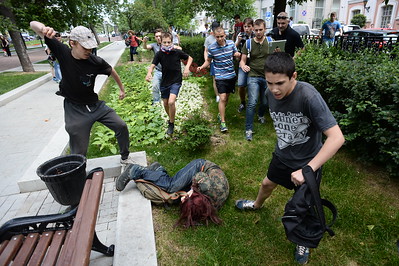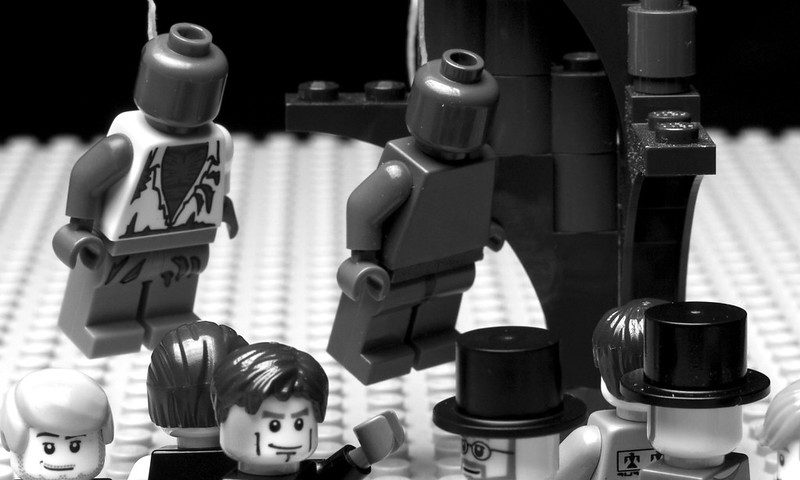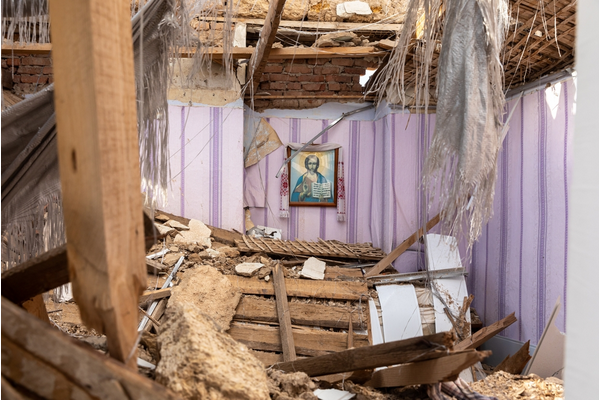


The Covid Debt Must Prepare the Future
8 July 2021Reading and Rereading Halévy
8 July 2021 ‘There is no greater law firm than Smith & Wesson, especially if it’s backed up by a 12-gauge injunction.’
‘There is no greater law firm than Smith & Wesson, especially if it’s backed up by a 12-gauge injunction.’
A member of the American vigilante group ‘Posse Comitatus’ thus graphically captured the essence of his activism in 1978. To take justice into one’s own hands, in a group or alone, is the credo of ‘vigilantism’, which is increasingly taking hold across the world. What does this term refer to, exactly? What are the origins and forms of this movement? CERI researchers Gilles Favarel-Garrigues and Laurent Gayer tackled these questions in their recently published study Fiers de punir. Le monde des justiciers hors-la-loi (Proud to punish. The world of outlaw vigilantes – Seuil, 2021). Interview.
Your book explores the global landscapes of ‘rough justice’ and discusses the concept of vigilantism in a comparative perspective. Would you mind defining this concept?
The concept of ‘vigilantism’ finds its origins in the forms of rough justice that developed in the United States during the nineteenth century. In the South and later in the West, self-styled punishers organised under the banner of ‘Vigilance Committees’, while the Spanish term for watchman, vigilante, started being used to refer to those fighting against horse thieves and other outlaws, in the face of a formal justice system deemed either absent or ineffective. Later, the term vigilantism came to designate a social phenomenon with a more global outreach. It now encompasses initiatives by ordinary citizens determined to deliver their own brand of justice, in the name of a community of reference, who is also to be their witness. Claiming to be invested by a popular mandate, these vigilantes do not hesitate to break the law to defend legal and moral norms. The term ‘vigilantisme’ is a recent addition in French but we are not the first scholars to use it: our colleague at CERI, Laurent Fourchard, has helped to popularise it through his research on South Africa and Nigeria(1)Fourchard, Laurent, Trier, exclure et policer. Vies urbaines en Afrique du Sud et au Nigeria. Paris, Presses de Sciences Po, 2018..
What vision of society – and of the world – does the practice of vigilantism convey?
In American history, the archetypical vigilante is an Angry White Man, eager to defend his family, his property, or his neighbourhood. At the end of the nineteenth century, this form of rough justice tended to coincide with the history of lynching: at the time, the punishment of alleged crimes (robberies, rapes) merged with the defence of the prevailing social and racial order. Since the end of the 1960s, however, these stereotypes have been challenged by racial minorities, when they set up self-defence groups in deprived inner cities. Beyond the United States, vigilantes can be found among merchants and landowning elites determined to organise themselves against thievery rather than relying on the police. The vision of society that these vigilantes promote is often laden with prophylactic considerations: by eliminating people considered to be ‘parasites’, ‘scum’, ‘waste’, they strive for social cleansing.
You have been working for several years on issues of vigilantism and private justice in your respective fields of research – in Russia, India, and Pakistan – and you have set up a research group on these topics…
This book owes a lot to the discussions that we have had over the years with our students and colleagues. The course we teach in the research master’s programme in comparative politics has played a key role. Indeed, in many regards this class has taken the form of a research seminar and our students have often been the first public with whom we shared our hypotheses, our findings, and our doubts. We would like to thank them and recall that research and teaching both benefit from being thought of in a complimentary way.
Beyond this class, we have had the chance of organising several research groups at CERI with our colleagues and PhD students, as well as through a Joint-Chair with the Center for International Studies and Research (CERIUM) at the University of Montréal. These collaborations gave us the opportunity to discuss our work and ongoing research on vigilantism and policing, in France and abroad. They resulted in the publication of a special issue – Breaking the Law to Maintain Public Order. Debating Vigilantism – of the journal Politix. We enjoyed writing the introduction to this issue together and decided to pursue this collaboration further.
How did you choose the cases that you study in this book?

Des militants LGBT attaqués lors d’une action “Journée des baisers” contre un projet de loi homophobe à Moscou. ©
Roma Yandolin, CC BY-SA 2.0, Flickr
Fiers de punir is a book in which the reader gets to travel a lot. We are, of course, influenced by our respective fieldwork, in India, Pakistan, and Russia. Many cases discussed in the book are drawn from these countries, and whenever possible we worked with primary sources in vernacular languages. However, our ambition was to go beyond our comfort zone to consider other contemporary forms of vigilantism, from the United States to Asian, African, and Latin American contexts, without forgetting the current development of digital vigilantism. In this endeavour, we greatly benefited from recent developments in the anthropological literature on extralegal punishments. Finally, we wanted to close our exploration of the global landscapes of rough justice by considering the French context, which is not immune to the development of vigilantism, as many recent controversies have shown: farmers patrolling to defend their horses against attacks, vigilantes laying traps for alleged paedophiles, youth groups attacking and attempting to lynch Roma in 2019, for instance.
What general claims result from your respective studies in this book?
One of our ambitions is to draw some sort of continuum of self-justice, with voluntary and spontaneous forms of vigilantism on one end and punishers in uniforms on the other, who undertake the state’s dirty work with at least implicit support of authorities. These executioners belong to police or military services and hold a mandate that authorises them to use extrajudicial violence to fight against delinquency or quell opponents. The death squads that appeared in Brazil in the late 1950s and that were later observed in several other Latin American countries constitute the archetype of this form of state-sponsored rough justice. In contexts such as Duterte’s Philippines, Modi’s India, and Bolsonaro’s Brazil, we see the emergence of a vigilante state insofar as in these countries, segments of the political elite denounce the state’s laxity, promote summary justice, and entrust this task to law enforcement officers who are more or less explicitly authorised to dispense with legal niceties.
We can easily imagine that studying practices of vigilantism is not self-evident, that you must take a step back to verify your sources and collected data…
Each chapter unfolds around three main themes. First, we have paid attention to the statements of vigilantes appearing in pamphlets, communiqués or interviews, which reflect their worldview and conception of justice: how do they justify taking the law in their own hand? Then we have turned to the use of coercion by these self-styled enforcers. For this purpose, we mainly used the videos produced and circulated by vigilantes themselves (on YouTube or WhatsApp, for example) and the reports compiled by observers and law enforcement agencies. Finally, we were interested in the controversies generated by the vigilantes, who have been glorified in popular culture (genre movies, comic books, pulp fiction, hagiographical poems, etc.) as much as they were demonised for their excesses.

Affiche d’un film pachtoune dans un cinéma de Karachi. A l’instar de son homologue pendjabi, le cinéma pachtoune accorde une place centrale à la vendetta et aux figures de justiciers hors-la-loi. © L. Gayer
You write that the critique of the judicial system inspires some citizens to take the law in their own hands. But even as they enforce their own brand of summary justice, they replicate the processes and mimic the rituals of formal judiciary institutions. How do you explain this paradox?
All self-appointed avengers, whether they reflect citizens’ initiatives or are supported by the state, share a deeply rooted distrust toward due process and the rule of law. In every case, they consider that the judicial system is too slow, too distant, too procedural, or too lenient. They advocate a form of summary and uncompromising justice. They take charge of the entire judicial process by acting as investigators, police officers, prosecutors, judges, and executioners. They administer proof following various regimes of truth and they subscribe to an exemplary and spectacular form of justice that inflicts bodily pain for purposes of punishment, deterrence and entertainment.
These self-proclaimed vigilantes are proud of their punitive operations, of their mission. In a certain way, they are also proud of calling into question the monopoly of the state’s sovereignty on policing and on justice. As you mentioned earlier, this occurs, in certain circumstances, with the complicity of the state…
In most cases, vigilante justice challenges public authorities by seizing sovereign prerogatives in the name of law and order. In many incidents of lynching, the police are also targeted, for example when vigilantes strive to get hold of suspects in custody or when police officers try to retrieve the body from the crowd. However, in many other instances, the complicity of the police – keen to get rid of criminals they also deem harmful – is patent. When it comes to punishers in uniform, the support of authorities for this type of extrajudicial violence is more obvious but it is never granted. Political protections are always reversible and are contingent on public controversies fuelled by state-sponsored executioners. Political elites can indeed easily disassociate themselves from those avengers who have become liabilities.
Intervieww by Miriam Périer, CERI
Gilles Favarel-Garrigues is a CNRS research director at CERI and works on issues of deviance, violence, police and justice based on surveys conducted mainly in Russia. CNRS research Director at CERI, Laurent Gayer is a specialist of the Indian subcontinent, focusing on urban dynamics and violent mobilisations in India and Pakistan.
Abrahams, Ray, Vigilant Citizens: Vigilantism and the State, Polity Press, 1998.
Campbell, Bruce, Brenner, Arthur ( eds), Death Squads in Global Perspective: Murder with Deniability. St. Martin’s Press, 2000.
Carrigan, William, Waldrep, Christopher (eds.), Swift to Wrath. Lynching in Global Historical Perspective, University of Virginia, 2013.
Fourchard, Laurent, Trier, exclure et policer. Vies urbaines en Afrique du Sud et au Nigeria. Paris, Presses de Sciences Po, 2018
Pfeifer, Michael (ed.), Global Lynching and Collective Violence. Vol. 1: Asia, Africa and the Middle East; Vol. 2: The Americas and Europe, University of Illinois, 2017.
Pratten, David, Sen, Atreyee (eds.), Global vigilantes , Hurst & Company, 2007.
Notes
| ↑1 | Fourchard, Laurent, Trier, exclure et policer. Vies urbaines en Afrique du Sud et au Nigeria. Paris, Presses de Sciences Po, 2018. |
|---|



